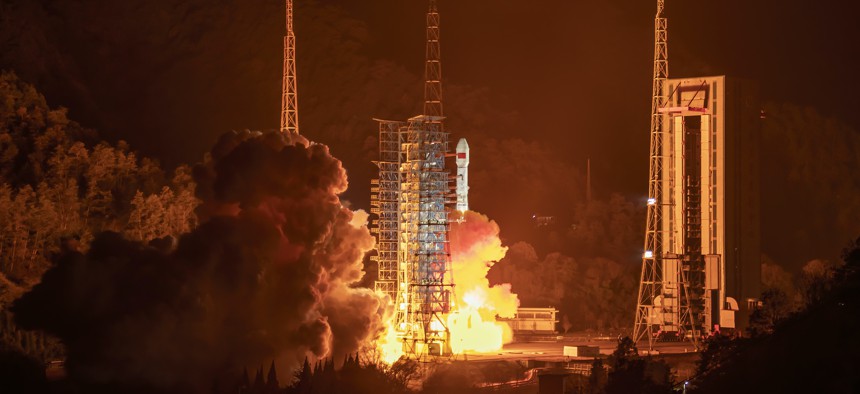
A Long March 3B carrier rocket carrying an experimental satellite blasts off from the Xichang Satellite Launch Center on December 30, 2021 in Xichang, China. Liu Guoxing / VCG via Getty Images
The US and China Could Soon Be In Race For Nuclear-Powered Satellites
An idea from the 1960s has found new backers.
If future U.S. satellites are to dodge incoming Russian or Chinese fire, they’ll need better ways to move around than today’s fuel-intensive thrusters. That’s why the Pentagon is looking into nuclear-powered propulsion.
While leaders at the Space Force and the Pentagon Research and Development office remain publicly quiet about the idea of putting nuclear-powered spacecraft in orbit, the Mitchell Institute for Aerospace studies released a new report that argues for more focused work on it.
It isn’t a new concept. NASA and the Atomic Energy Commission were working toward a flight test for their nuclear rocket until the Vietnam War sapped the program’s funding. It was cancelled in 1973, and safety concerns have since scuttled further efforts.
But nuclear propulsion has some big advantages over hydrazine—conventional liquid satellite fuel—according to the Mitchell Institute. It has longer endurance and is nearly twice as efficient, so you need half as much mass to generate the same amount of thrust. In the form of an engine, it can “deliver more than 100,000 Newtons of thrust—that’s enough power to accelerate a typical automobile from 0 to 60 miles per hour in 0.3 seconds,” the report notes. That could be crucial in helping key satellites that perform functions like navigation, or spotting missile launches to move to other orbits in order to avoid space weapons.
Military leaders have been hesitant to back such ideas publicly.
On Thursday, Heidi Shyu, defense undersecretary for research and engineering, wouldn’t comment on the idea, except to say that the Defense Department’s primary strategy for protecting satellite functions is resilience through proliferation: having too many satellites to shoot down. When asked specifically about nuclear power for maneuvering, she said, “We're looking at a multitude of different things. It isn't just one technology or one strategy.”
But one DARPA official, at least, suggests looking at the idea afresh. A 2020 policy change from the Trump White House has clearing the way for new research into nuclear propulsion, Micheal Leahy, the director of the tactical technology office at DARPA, told a virtual audience on Friday. Leahy’s office runs the DARPA Demonstration Rocket for Agile Cislunar Operations, or DRACO, program. Last April, DARPA awarded General Atomics a contract for a preliminary design of a reactor and propulsion subsystem, and gave Lockheed Martin and Blue Origin a contract for a spacecraft design.
But the bigger factor is thatChina is working along similar lines with planes to field its own nuclear-powered satellites by 2040. The lessons from the current gap in hypersonic missile technology should provide a cautionary tale, Leahy said.
“We had the lead in hypersonics, only to watch it go away. Right?... Now I’m in a tail chase,” he said.




